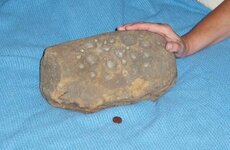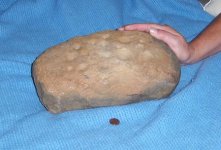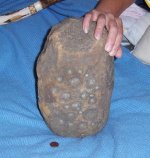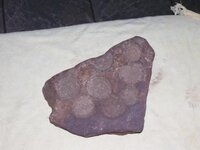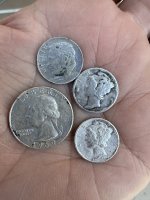You are using an out of date browser. It may not display this or other websites correctly.
You should upgrade or use an alternative browser.
You should upgrade or use an alternative browser.
Workbench?
- Thread starter MEinWV
- Start date
schlooppy
Sr. Member
Looks like a large nutting stone. Nice find.
aa battery
Gold Member
Thats a great find never seen one like that 8) aa
A
Atlantis0077
Guest
Morning,
That looks like a large, multi-hole nutting stone. I have found and seen several like it, including one that is round with in excess of 50 holes. I have NO idea what they would have used such a stone for, but the Indians were efficient in much that they did so I am sure there was a perfectly logical reason for them.
There are also stones out there that that nature makes that closely resemble nut stones. I have included a photo of such a stone. When you look at it remember that it has holes on both sides. It looks great and I kept it thinking it was a nut stone, but am now beginning to have my doubts it was actually made, but rather a unique geofact.
Happy Hunting,
Atlantis
That looks like a large, multi-hole nutting stone. I have found and seen several like it, including one that is round with in excess of 50 holes. I have NO idea what they would have used such a stone for, but the Indians were efficient in much that they did so I am sure there was a perfectly logical reason for them.
There are also stones out there that that nature makes that closely resemble nut stones. I have included a photo of such a stone. When you look at it remember that it has holes on both sides. It looks great and I kept it thinking it was a nut stone, but am now beginning to have my doubts it was actually made, but rather a unique geofact.
Happy Hunting,
Atlantis
Attachments
Adena_man
Hero Member
Man that is one big nutter! How far did you have to lug that thing back to your vehicle? Nice find!
MEinWV
Bronze Member
- Thread starter
- #7
Thanks for the great ideas and comments. I would like to explore an idea I have about this object. I have seen this type referred to as an "anvil" stone. In the area I live, flint quarries are a few days walk away. With the exception of trade, the flint that the local natives used here were waterworn nodules that resemble a potato. These nodules would have to be placed on a hard object and then struck with a hammerstone. They may have been struck several times to get some desired flakes for making arrowheads.
I call this anvil stone a workbench because it shows various depressions in it. One is a large, well rounded one and a couple smaller rounded ones that I would consider for the cracking of nuts. Others are conical with a single straight crease in them, while others are a triangular shaped cone. Some of these I believe are used to transform the flint nodules to a shape suitable for fashioning arrowheads. I'm not sure that calling everything with a depression in it a nutting stone is the way to go. The term anvil stone would better suit these objects, simply because it covers all possible uses for the piece.
I would love to hear any other thoughts or ideas about this.
Thanks!........HH
I call this anvil stone a workbench because it shows various depressions in it. One is a large, well rounded one and a couple smaller rounded ones that I would consider for the cracking of nuts. Others are conical with a single straight crease in them, while others are a triangular shaped cone. Some of these I believe are used to transform the flint nodules to a shape suitable for fashioning arrowheads. I'm not sure that calling everything with a depression in it a nutting stone is the way to go. The term anvil stone would better suit these objects, simply because it covers all possible uses for the piece.
I would love to hear any other thoughts or ideas about this.
Thanks!........HH
ohioriver hunter
Sr. Member
- Apr 12, 2007
- 481
- 4
Super find I found one like it but it is too big and heavy to carry home.MEinWV said:Hey fossis! This is the "workbench" that I described in your post. It is about 11"L X 7 1/2" W X 5" high. It weighs about 15 lbs. I have looked on many sites trying to find info, but not finding much. I saw 2 of these down at Fort Boonesboro, KY.
Jeff
MEinWV
Bronze Member
- Thread starter
- #9
Up and over a 10 foot riverbank cut (that was the worst part). Then about a 400 yard stroll to the truck.Adena_man said:Man that is one big nutter! How far did you have to lug that thing back to your vehicle? Nice find!
Of course, I would do it again in a second if it took me all day!
Top Member Reactions
-
 2576
2576 -
 1142
1142 -
 1044
1044 -
 911
911 -
 892
892 -
 842
842 -
 808
808 -
 701
701 -
 642
642 -
 530
530 -
 495
495 -
 481
481 -
 472
472 -
 470
470 -
 463
463 -
O
440
-
 422
422 -
 391
391 -
 381
381 -
 364
364
Users who are viewing this thread
Total: 2 (members: 0, guests: 2)


